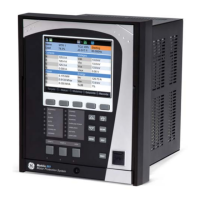4–112 869 MOTOR PROTECTION SYSTEM – INSTRUCTION MANUAL
PROTECTION CHAPTER 4: SETPOINTS
Thermal Model
The Thermal model is the primary protective function of the 869. It consists of five key
elements:
• Thermal model curve (overload)
• Overload pickup level
• Unbalance biasing of the motor current while the motor is running
• Motor cooling time constants
• Biasing of the thermal model based on hot/cold information and/or measured stator
te
mperature
The algorithm integrates both stator and rotor heating into a single model. The motor
hea
ting level is maintained in the Thermal Capacity Used (TCU) register. If the motor has
been stopped for a long time, it will be at ambient temperature and the Thermal Capacity
Used will be zero. If the motor is in overload, the output operand is set once the thermal
capacity used reaches 100%.
Once the motor load current exceeds the overload level (FLA x overload factor), it enters an
ov
erload phase; that is, the heat accumulation becomes greater than the heat dissipation.
The 869 thermal model reacts by incrementing the Thermal Capacity Used at a rate
depend
ent on the selected thermal curve and overload level. When the thermal capacity
reaches 100%, the Thermal TRIP OP operand (typically configured to trip the motor) is set.
The Thermal Trip OP and output relays will remain asserted until the current drops below
the OL*FLA level and the Reset command is initiated or the Emergency Restart input is
asserted.
In the event of a loss of control power to the relay while the motor status is not Motor
S
topped or Tripped, the thermal capacity will remain unchanged when control power is
restored.
If the motor status is Motor Stopped or Tripped when control power is lost, the thermal
cap
acity will decay for the duration of the loss of control power based on the stopped
motor cooling rate if the real time clock (RTC) was working properly during the power loss.
However, if clock was not working properly, the TCU value will remain unchanged when the
relay power is restored.
Path:
Setpoints > Protection > Group 1 > Motor > Thermal Model
TRIP FUNCTION
Range: Disabled, Trip, Configurable
Default: Disabled
The setting enables the Thermal Model trip functionality.
OVERLOAD CURVE
Range: Motor, Flexcurve A, Flexcurve B, Flexcurve C, Flexcurve D, IEC
Default: Motor
The thermal model curve determines the thermal limit overload conditions that can
damage the motor. This curve accounts for motor heating in both the stator and rotor
during stall, acceleration, and running conditions. The overload curve can take one of six
formats: Motor, FlexCurve A, FlexCurve B, FlexCurve C, FlexCurve D, or IEC. The selected
curve (except IEC) can also serve as a base for a voltage dependent overload curve if the

